The Samsung Galaxy S20+, S20 Ultra Exynos & Snapdragon Review: Megalomania Devices
by Andrei Frumusanu on April 3, 2020 9:30 AM ESTMachine Learning Inference Performance
The new SoC generations also bring with them new AI capabilities, however things are quite different in terms of their capabilities. We saw the Snapdragon 865 add to the table a whole lot of new Tensor core performance which should accelerate ML workloads, but the software still plays a big role in being able to extract that capability out of the hardware.
Samsung’s Exynos 990 is quite odd here in this regard, the company quoted the SoC’s NPU and DSP being able to deliver a 10TOPs but it’s not clear how this figure is broken down. SLSI has also been able to take advantage of the new Mali-G77 GPU and its ML abilities, exposing them through NNAPI.
We’re skipping AIMark for today’s test as the benchmark couldn’t support hardware acceleration for either device, lacking updated support for neither Qualcomm’s or SLSI’s ML SDK’s. We thus fall back to AIBenchmark 3, which uses NNAPI acceleration.
AIBenchmark 3
AIBenchmark takes a different approach to benchmarking. Here the test uses the hardware agnostic NNAPI in order to accelerate inferencing, meaning it doesn’t use any proprietary aspects of a given hardware except for the drivers that actually enable the abstraction between software and hardware. This approach is more apples-to-apples, but also means that we can’t do cross-platform comparisons, like testing iPhones.
We’re publishing one-shot inference times. The difference here to sustained performance inference times is that these figures have more timing overhead on the part of the software stack from initializing the test to actually executing the computation.
AIBenchmark 3 - NNAPI CPU
We’re segregating the AIBenchmark scores by execution block, starting off with the regular CPU workloads that simply use TensorFlow libraries and do not attempt to run on specialized hardware blocks.

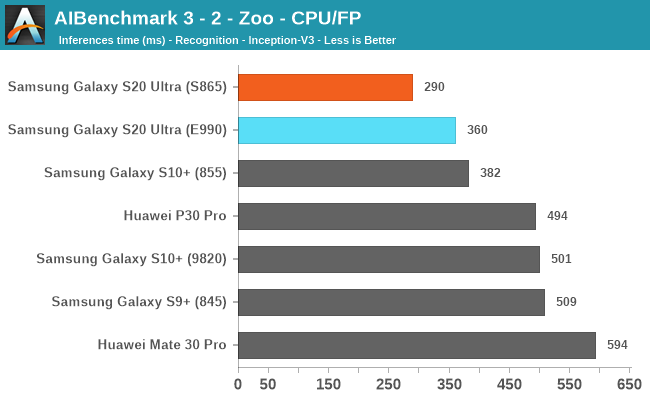

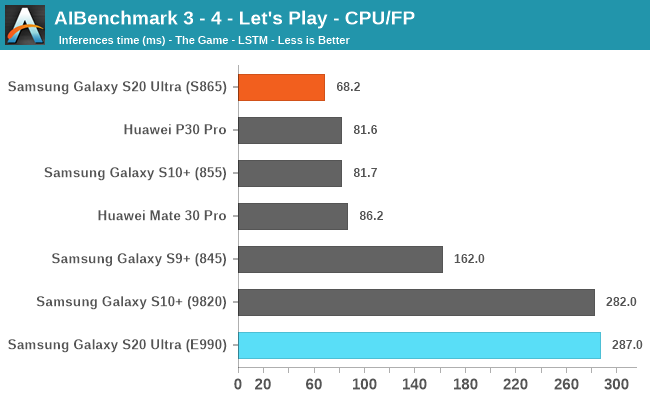

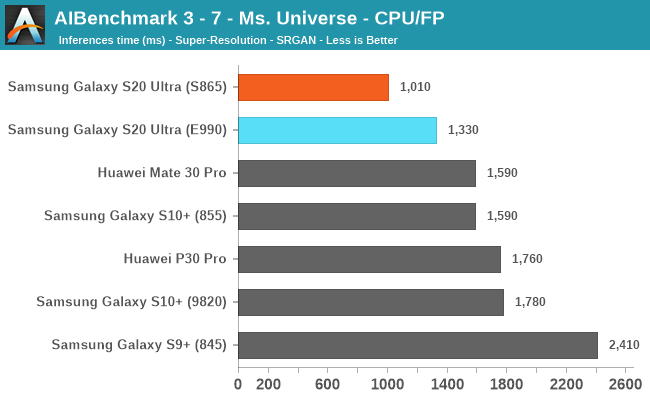

In the purely CPU accelerated workloads, we’re seeing both phones performing very well, but the Snapdragon 865’s A77 cores here are evidently in the lead by a good margin. It’s to be noted that the scores are also updated for the S10 phones – I noted a big performance boost with the Android 10 updates and the newer NNAPI versions of the test.
AIBenchmark 3 - NNAPI INT8
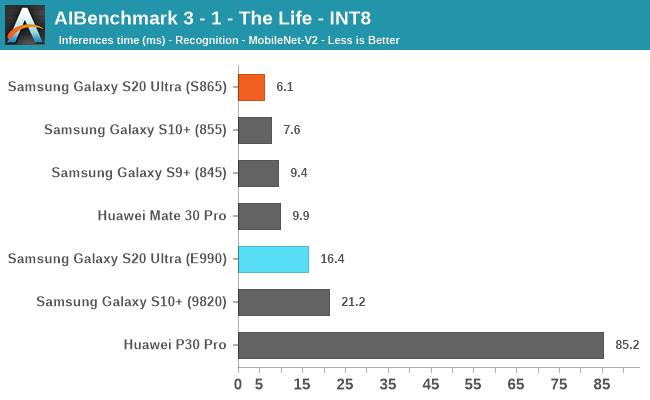
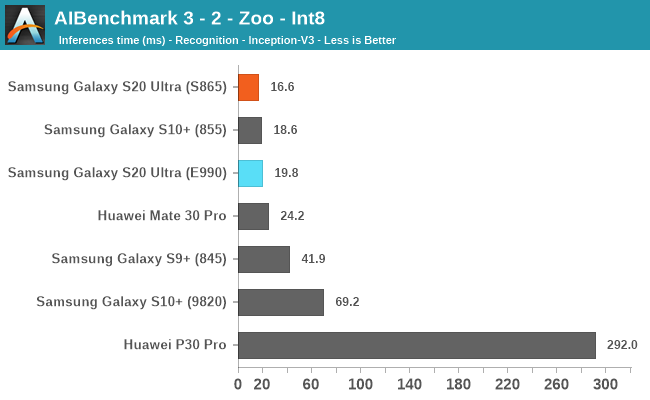
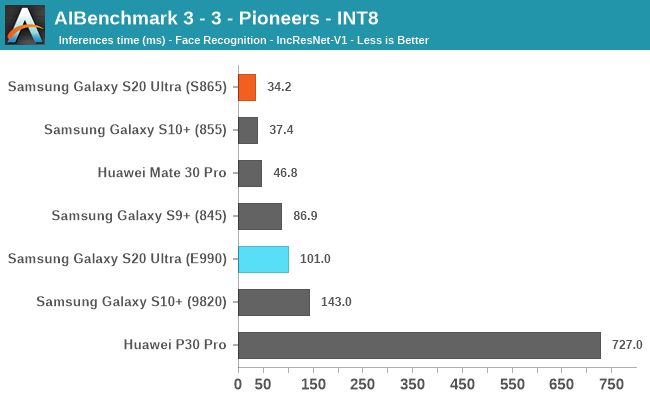
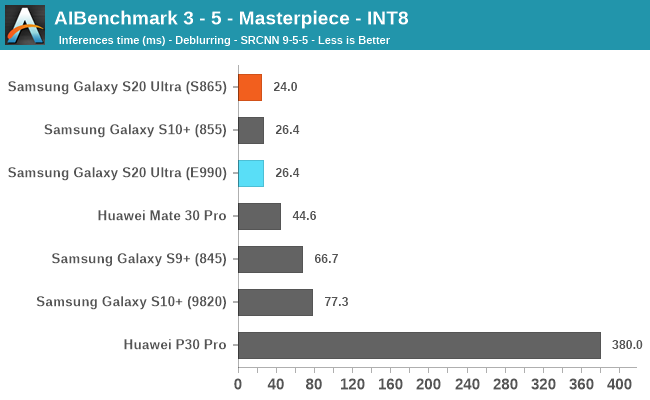
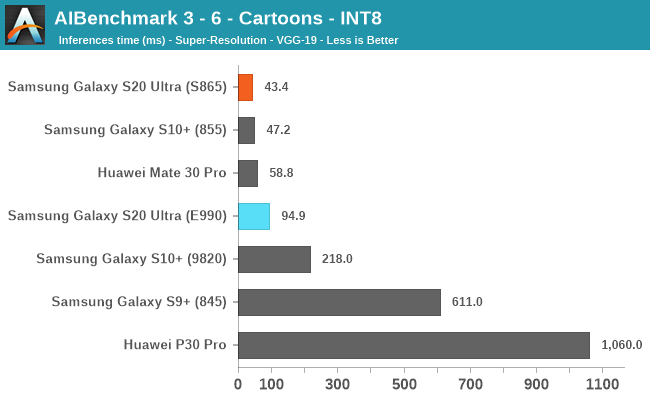
Integer ML workloads on both phones is good, but because the Snapdragon 865 leverages the Hexagon DSP cores for such workload types, it’s much in lead ahead of the Exynos 990 S20. This latter variant however also showcases some very big performance improvements compared to its predecessor. I still think that Samsung here is only exposing the GPU of the SoC for NNAPI, but because of the new microarchitecture being able to accelerate ML workloads, we’re seeing a big performance improvement compared to the Exynos 9820.
AIBenchmark 3 - NNAPI FP16
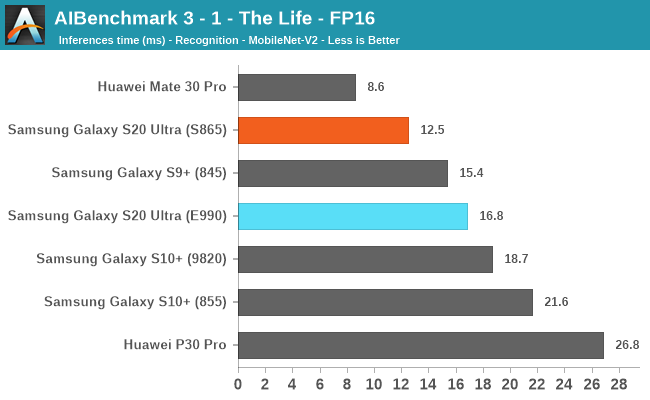
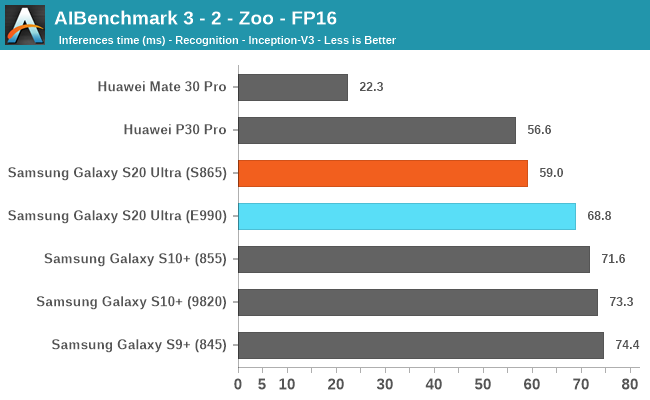
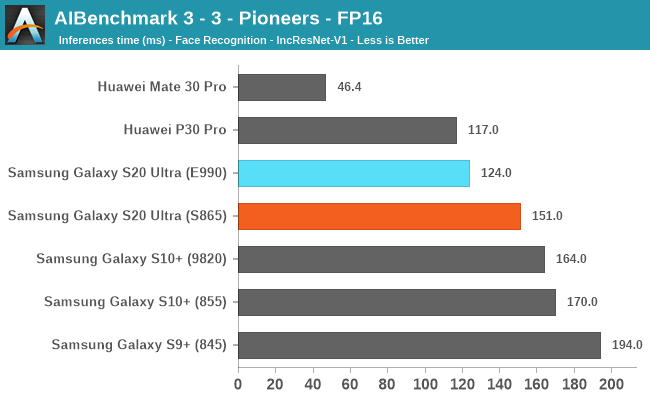
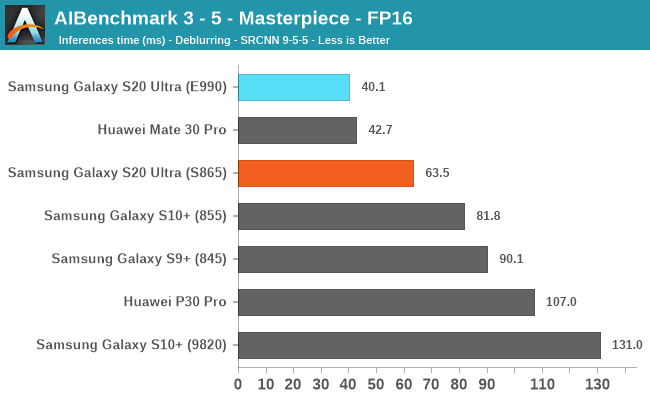
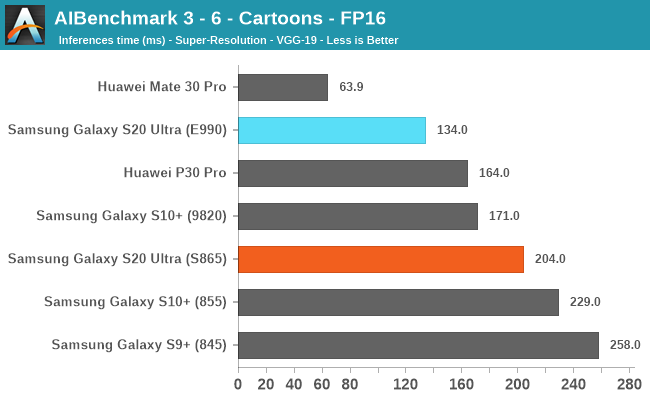
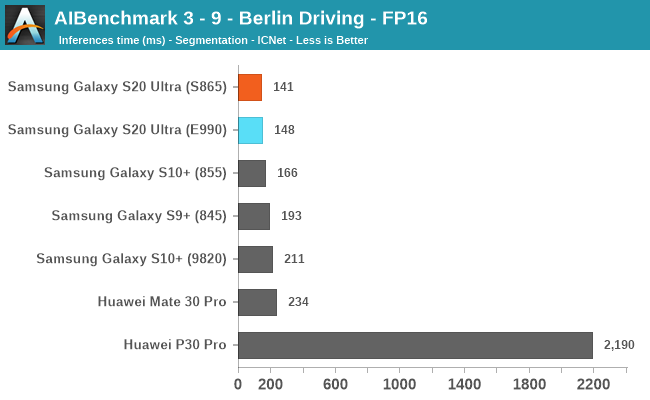
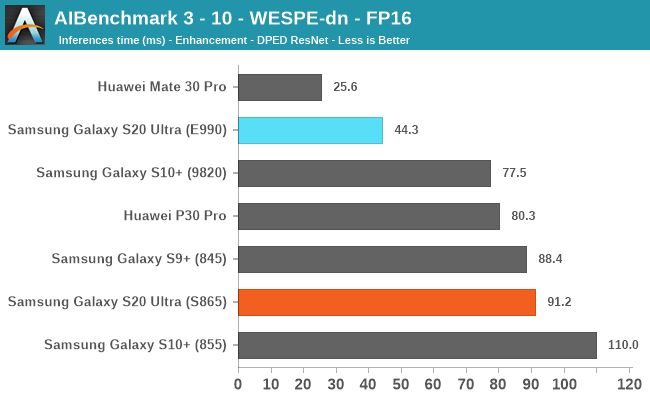
In FP16 workloads, the Exynos 990’s GPU actually manages to more often outperform the Snapdragon 865’s Adreno unit. In workloads that allow it, HiSilicon’s NPU still is far in the lead in workloads as it support FP16 acceleration which isn’t present on either the Snapdragon or Exynos SoCs – both falling back to their GPUs.
AIBenchmark 3 - NNAPI FP32
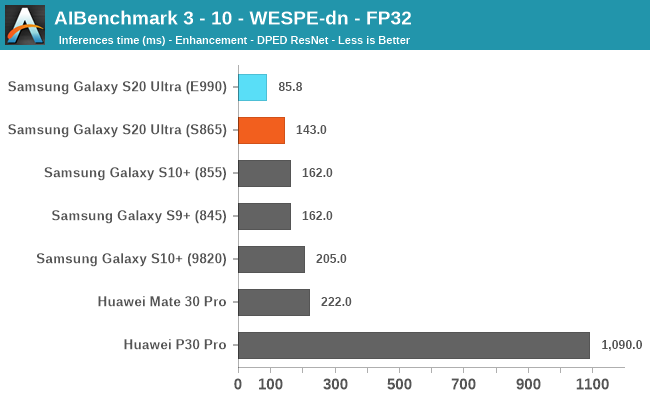
Finally, FP32 also again uses the GPU of each SoC, and again the Exynos 990 presents quite a large performance lead ahead of the Snapdragon 865 unit.
It’s certainly encouraging to see the Samsung SoC keep up with the Snapdragon variant of the S20, pointing out that other vendors now finally are paying better attention to their ML capabilities. We don’t know much at all about the DSP or the NPU of the Exynos 990 as Samsung’s EDEN AI SDK is still not public – I hope that they finally open up more and allow third-party developers to take advantage of the available hardware.










137 Comments
View All Comments
StrangerGuy - Wednesday, April 8, 2020 - link
$1400? Geez, I thought $1100 for the Ultra here in Singapore was already stupid overpriced especially when all S20 variants here are only available in 128GB and the Note 10+ 256GB is just $590.Cliff34 - Friday, April 3, 2020 - link
When I upgraded from s3 to s7, I was so impress by the new phone. Long battery life, great camera and fast cpu.Now I upgraded to s20+ and instead of feeling the aww feeling, I'm more like meh.
It comes w great features but they are all come w a cost. Great camera but if you take 64meg photos, it takes a few seconds to process. Great screen but if you switch on 120 hertz, your battery drains fast.
Hindsight, s20 is good enough for me.
philehidiot - Friday, April 3, 2020 - link
This is why I simply won't buy a new phone until I've waited for the Anandtech review. It takes a long time to come out and even longer to read but it has saved me a few bad decisions and premature upgrades. As well as a tonne of cash. I'm still on my S8 and the missus is on the S7 and y'know what? They're just fine. My only issue with the S8 is a recent update which is resulting in markedly increased screen brightness when set to auto. Try and drag the brightness back down and it just goes back up again. I can only imagine that "feature" was added to convince people it's time to upgrade. The only other issue is a bit of lag here and there but it's not a massive issue. I'm in the UK, so I absolutely will NOT pay Samsung for a product that is so inferior to other markets but they market and expect me to value exactly the same. I'm no problem with different internals for different markets and I've no problem with parts being sourced from different suppliers. BUT, you either change the price to reflect the value or you keep the specs of the different parts near enough the same if you want the value to be the same.Now, if you'll excuse me, for some strange reason my middle finger has gone stone cold and needs a rest. As if the blood has drained from it as a result of spending so much time erected in Samsung's direction.
phoenix_rizzen - Friday, April 3, 2020 - link
Install Lux and let that manage the auto-brightness. On the S6, S7, and A8 (2018), Lux does a much better job managing brightness than Samsung's settings. And you can set your own targets for "at this level of ambient light, set the brightness to this level", which is especially handy for lower light levels.On the S10e, I haven't bothered to install Lux, as Samsung's Adaptive Brightness eventually catches up to my preferences and is working well enough.
philehidiot - Friday, April 3, 2020 - link
Ahh sweet, cheers! I'll have a look at that now. The adaptive brightness has worked fine for several years and only since an update has it gone very strange.shabby - Friday, April 3, 2020 - link
Can all the cameras on the s20+ record in 4k60fps? In the s10 only the main one could so you couldn't record in 4k60 while switching between the sensors.Andrei Frumusanu - Friday, April 3, 2020 - link
It's unfortunately still only limited to the main camera module.shabby - Friday, April 3, 2020 - link
Damnitiamlilysdad - Friday, April 3, 2020 - link
While waiting for display accuracy comparison charts, can you post "old style" dE results so we can do our own comparisons? Or, even better, provide a timeline and list of devices that you're going to go back and retest using the new methodology/rating system?FunBunny2 - Friday, April 3, 2020 - link
I'm not a phone junkie, doh!, but isn't refresh rate tied to content/application coding? IOW, only content/applications written to display at 120 will benefit? Otherwise, won't the screen just refresh twice on the 60hz line?